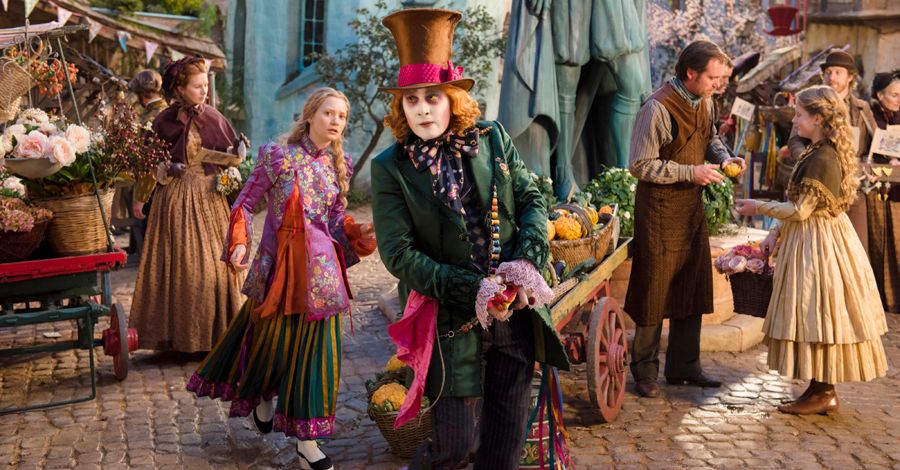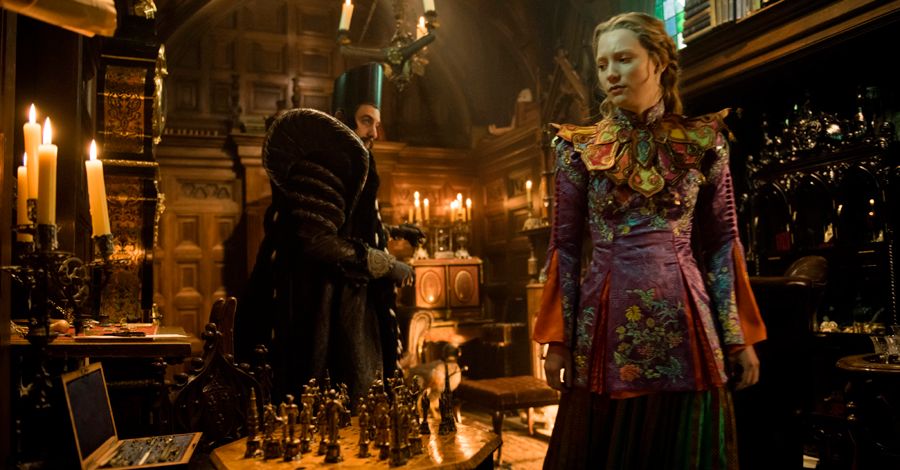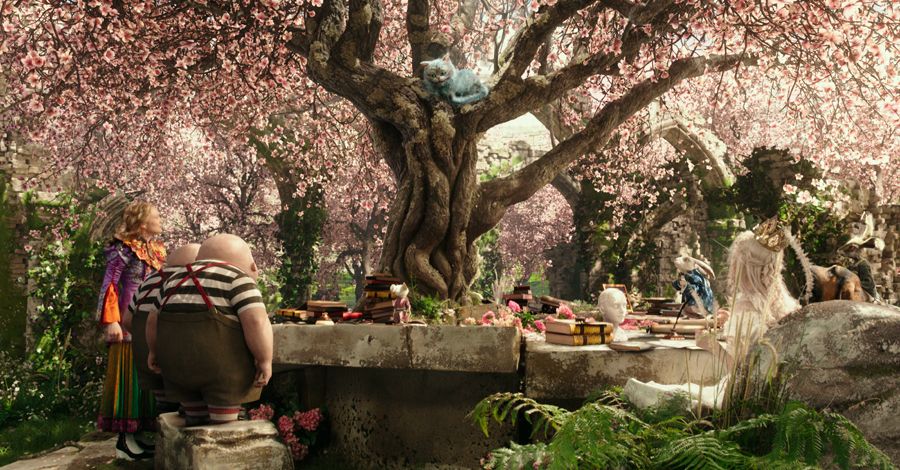It took author Lewis Carroll six years to deliver a follow-up to his 1865 novel “Alice’s Adventures in Wonderland,” and so it seems only appropriate that six years after Disney’s release of the Tim Burton live-action adaptation, the sequel “Alice Through the Looking Glass” arrives in theaters.
James Bobin (“The Muppets”) slips into the director’s chair this time around, with Johnny Depp reprising his eccentric role as the Mad Hatter.
SPINOFF was present when Bobin and producer Suzanne Todd convened with returning actors Mia Wasikowka and Anne Hathaway for a peek inside the new film.
On what they both brought to the project and discovered along the way as it evolved:
Suzanne Todd: Well, it took us a long time after the first movie to really come up with an idea that we felt was worth taking on. These movies are very difficult to make, so we went back into the literature. We went back into what’s been so popular for 150 years, and themes came up that we were interested in that Linda Woolverton, the screenwriter, wanted to take on, and when James came on board, what he was interested in.
And we really focused on what you’ve seen in the movie now, which is time, and the preciousness of time, and the importance of spending time with loved ones. Also, what a pretty kick-ass girl can do if she sets her mind to it, which we love that.
Writer Linda Woolverton Returns to Wonderland With "Alice Through the Looking Glass"
James Bobin: I’m English, so I think when you grow up with “Alice,” it’s a part of your life. It’s in your parents’ house and grandparents’ house. You read the story to your own kids. So I really thought I knew who Alice was, to me. The Alice in this film, I think Mia is really my idea of what Alice in the book would be like if she’s grown up, which I love very much. I think that’s what this one should be about.
But also, I remember reading Lewis Carroll as a kid and he made me laugh. Obviously, a lot of stuff I’ve done in the past has been to do with comedy, so I wanted to try and bring elements of that to this story because I always feel that he’s the author of absurdist, surrealist humor, which you can trace pretty much a direct line to “Monty Python” -- which again, is part of my growing up.
Mia Wasikowska: It was really unexpected. I didn’t think it was going to happen, then I was really surprised when about, like, three years ago, they started talking about it again. But it was really great. It was nice. Six years have passed. Having already done the first film and worked with the cast and a lot of the creative team, I knew what I was stepping into a second time around, and it was really enjoyable because of that.
I think at the beginning of this film, she’s been traveling around the world for the last two years. She’s the captain of her own ship, so she’s coming from a very empowered place. I just love that she has this really strong sense of who she is and despite the fact that expectations of her are really low when she returns to England, she’s able to kind of honor up, to sense that she’s worth more than what other people want of her.
Bobin: This character is not a superhero. She’s a girl who’s brave and has intelligent thoughts. So when you watch the sequences, I was very keen that we made sure that Alice struggles to do these things. It’s not easy. She’s a sea captain, she’s a real person, so she can climb the rigging, but it’s not easy. She can jump on to the giant hands of a clock, but she falls over. It’s not easy. So I didn’t want to make her feel to competent in those situations. You wouldn’t be. You’re competent because you’re brave and you’re strong and you’re determined. So that was the kind of basis of the action.
Anne Hathaway: It was fun to learn that [the White Queen’s] not perfect. I think she’s sort of lovely in the first one, but a bit oppressively good. So it was nice to know that, like everyone, she’s got a past and she has regrets, and she feels shame, and she feels guilt, and that you can be forgiven for these things., so I actually was really thrilled that we were kind of trying to see what the emotions were about these characters that look so fantastical, but then feel so relatable.
I think Helena [Bonham Carter] is one of my favorite people on the planet Earth. I think the world’s better because she’s on it. She’s so inventive and fresh -- like literally, in all definitions of fresh. She’s got a wonderfully fresh mouth, and she’s fearless and she’s vulnerable, and she’s open, and she’s friendly, and I admire her so much. So it was really exciting for me to get to have more scenes with her this time around. Yes, because I got to work with an incredible actress, but also because I just got to talk to her between takes, which I loved. And I think we had a really nice time crafting the sister relationship together, and trying to make something that felt true to us and that other people would understand.
REVIEW: "Alice Through the Looking Glass" is a Senseless Trip Back Down the Rabbit Hole
On finding the proper tone and building out the Wonderland world for the screen:
Bobin: Tone is a result of a million decisions you make over the period of the production of the movie, so it’s something I was incredibly aware of. Obviously, Tim’s first movie looks so beautiful. It felt like a good parameter which I get to work with. But this film is obviously set in a different time period and geographical location, so I was allowed as the director to bring something of myself to it as well.
I really felt that, whilst we couldn’t tell the story of the book, because it wasn’t in its own way somewhat … the story has a much cause-and-effect, the scenes blend into one another, it’s quite unusual. But I wanted to pay tribute to him in the sense that it would be a story that he would appreciate.
I think even though time travel is kind of, as a literary conceit, is later than [Carroll], I think as a mathematician, he would appreciate the idea of time travel, because it’s equations and physics, basically. So I wanted to try and keep that part of it too, but at the same time, having time be a person, was of course Lewis Carroll’s idea. Lewis Carroll wrote in the book, when Hatter meets Alice for the first time, “I’ve been stuck here since last March when Time and I quarreled.”
So it was kind of those bits. It was basically trying to incorporate elements of Lewis Carroll whilst maintaining the Tim world, but then bringing something of what you think those things are.
Todd: When you talk about what you're talking about in terms of the achievement of the tone and the look, it is thousands and thousands – if not millions – of decisions. We were very lucky in many cases to have Danny Elfman come back to do the score, and Colleen Atwood, who won an Oscar for the first “Alice,” to come back and do the costumes.
We had a new production designer Dan Hennah, another Academy Award winner, who we were very lucky that we chose someone who really fit in and helped James, again, honor what Tim had done, but push it into something fresh and new that was James’ own thing. Ken Ralston doing visual effects obviously – coming back, he had been Oscar-nominated for the first movie, and Ken has won many other Oscars. Yes, it was many, many, I’d say, millions of decisions.
Wasikowska: Colleen Atwood is brilliant, and obviously such a genius, but also quite evil, because they’re very uncomfortable costumes. But in this one, I got to wear lots of trousers and things that were a lot more kind of accessible. Alice in this film is really active, so everything felt a little bit more … a suit at the beginning, and at the end, and even that oriental skirt is pants, also. So that was really great.
Hathaway: I wore no trousers. I would have loved it, actually! I thought that Colleen’s costume probably created my character. I knew I had certain kind of ideas about who she was, and then as soon as I put on the dress, I just said, “Oh, she’s air.” And all of a sudden you think about the relationship between her and Helena, and I thought, if you have a family member who has a large personality, has a lot of emotions, you compensate by taking up less space. So I thought, “Here’s somebody who’s literally turning herself into almost weightlessness, and yet, it’s still so ornamented.” So I just thought it was very rich and very airy, and that’s how I kind of came up with my airhead.
On the progressive nature of Alice as a protagonist, both in the film and the source material:
Wasikowska: There’s so many messages in this film that I think are really great. Even just with the message with time. There’s always things that we wish could do differently in the past but the best way to have peace with it is to accept it and then move forward and not try and change things. Yeah, as for the female, I mean, I guess it’s an anomaly to have a film, a big summer blockbuster, it has a female lead. I think it’s strange that that’s unusual. So hopefully that’ll become more normal.
Bobin: For me, a lot of this comes from Lewis Carroll himself, if you read the books. I have a daughter who’s about the same age as Alice, 8 or 9, and the characteristics she has, which is intelligent, brave, strong, fearful, is what Alice is. It feels Alice was a real girl. Alice was Charles Dodgson’s – who’s the real Lewis Carroll – boss’ daughter Alice Liddell. And she was born in the 1850s, and he wrote Alice for her, and about her, and I really think he saw in her the kind of eight-year-old girl as we all know her to be.
Particularly for girls in that time, as they grew older, society fell on them and made them make choices, which they didn’t necessarily want to. But he’s writing about girls that we know, because girls haven’t changed very much in their natural state. Eight-year-old girls are the same in a way., so I feel like that’s why the story’s lasted so long, because it’s so recognizable. The characteristics of that girl even though they were very unusual for the time, by the way we see girls.
What’s interesting about Alice Liddell, who is the girl from the book, is that she was born in 1852, and Emmeline Pankhurst, who founded the Suffragette Society in England, was born in 1858. So they are the same generation, and they, in the 1910s, got women the vote. So it was the real Alice generation of women who said ‘We’re not prepared to put up with the status quo anymore. Things need to change. This isn’t the way the world’s going to be. We’re going to make it different.”
And that’s an amazing thing, that Alice was a part of that generation. Maybe Lewis Carroll had a subconscious sense of that, that the world was changing, which I think is a fascinating idea.
Disney’s “Alice Through the Looking Glass” opens today nationwide.



